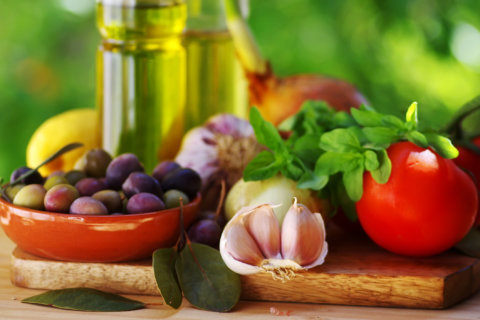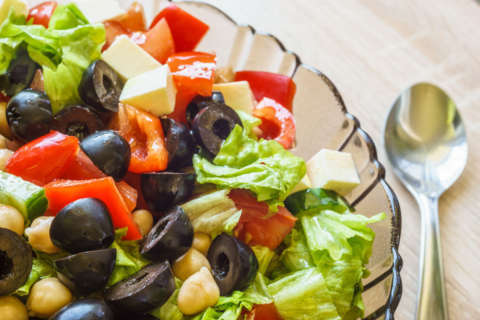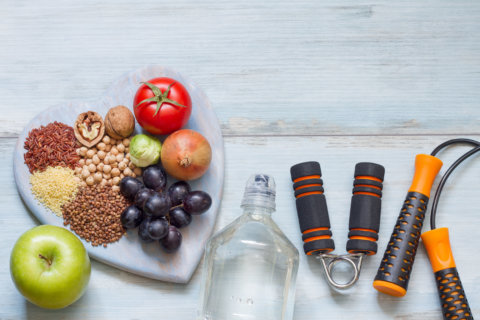A diet that’s good for healthy weight loss? Check. One that reduces the risk for diabetes, high cholesterol, heart disease, stroke and some cancers? Check. A diet that strengthens bones, improves brain health and wards off dementia and depression? Check.
According to scientific research, that impossible wish list is fulfilled by a diet common to residents of 21 sun-soaked countries that surround the Mediterranean Sea.
“Even though it’s called the Mediterranean diet, it’s not really a diet,” said Atlanta registered dietitian Rahaf Al Bochi, a spokesperson for the Academy of Nutrition and Dietetics. “It doesn’t tell you what to eat and not eat. It’s a lifestyle that encourages consuming all food groups, but gives more weight to those which have the most health benefits.”
Focus on plants
That means an emphasis on plants: fruits, vegetables, grains, nuts and seeds. Eat a lot of veggies and use all kinds and colors to get the broadest range of nutrients, phytochemicals and fiber. Cook, roast or garnish them with herbs and a bit of extra virgin olive oil.
Stay away from coconut and palm oil, warns Al Bochi. Even though they are plant-based, those oils are high in saturated fats that will raise bad cholesterol.
Add whole grains and fruit to every meal, although due to their high fat content, use nuts and seeds as a garnish or small snack.
On the Mediterranean diet, fish and other seafood are consumed at least twice a week. Cheese and yogurt show up daily to weekly, in moderate portions; chicken and eggs are okay on occasion, but the use of other meats and sweets is very limited.
A diet where meat is as rare as sweets? For anyone who thinks a meal is built around a portion of red meat, pork or chicken, the thought of a plant-based diet can seem overwhelming.
“It doesn’t have to be a complete overhaul overnight,” said registered dietitian Kelly Toups, “or be all-or-nothing for you to start to shift your health. When it comes to healthy eating, every bite counts.”
Add joyful movement and socialize
Toups is the nutrition director for Oldways, a non-profit nutrition organization dedicated to guiding people “to good health through heritage.” Its mission is to encourage healthy eating via the use of traditional diets based on African, Asian, Latin American and, of course, Mediterranean heritages.
As a visual way to encourage change, Oldways created the Mediterranean diet pyramid in 1993, in collaboration with the Harvard School of Public Health and the World Health Organization.
Interestingly, the ground level of the pyramid doesn’t focus on food at all. Instead, the greatest emphasis is placed on exercise, mindfully eating with friends and family, and socializing over meals.
“We encourage at least 20 minutes per meal,” said Al Bochi. “I understand that can be hard for a lot of people to implement, but start small. Turn off the TV, put away the cellphone, focus on meaningful conversations, chew slowly and pause between bites. That could be the start to your mindful eating journey.”
As for exercise, it doesn’t have to be in a gym.
“The Mediterranean lifestyle is walking with friends and family,” said Toups. “Instead of thinking of exercise as something that you have to do, just walk or dance or move in joyful ways.”
Move to whole grains
One of the easiest steps to take when starting the Mediterranean diet, says Toups, is to replace refined grains with whole grains. Choose whole wheat bread and pasta, and replace white rice with brown or wild rice.
To make sure that what you buy is actually whole grain, Oldway’s Whole Wheat Council has developed a black and gold “whole grains stamp” that manufacturers can voluntarily use, with each stamp listing the amount of whole grains in that product. The stamp is currently on 12,000 products in over 58 countries; consumers can search products by countries to find what they need.
“If you’re comparing two different loaves of bread, for example, one might have 18 grams of whole grain per slice and one might have 22,” said Toups. “So if you’re new to whole grains perhaps you want to start lower and work your way up.”
Grains that have changed little over the centuries, known as “ancient grains,” are also a key feature of the Mediterranean diet. Quinoa, amaranth, millet, farro, spelt, Kamut (a wheat grain said to be discovered in an Egyptian tomb), and teff (an Ethiopian grain about the size of a poppy seed), are some examples of ancient grains.
Each has a different taste and texture, so Toups suggests trying out one a month at home or at a restaurant.
“Mediterranean cuisine has been a popular trend for a while now,” Toups said. “It’s pretty easy to sample different Mediterranean grains and foods because these types of ingredients have become so popular in mainstream restaurants.”
At least six servings of grains, maybe more, are suggested each day, and at least half of those should be whole grain, says Toups. If you’re worried about the effect of carbs on your waistline, she suggests you look at the longer term benefits.
“We definitely get questions about these low-carb diets,” Toups said. “Just because something might help you lose weight quickly doesn’t mean it was healthy for your body to do it that way. You can lose weight by catching malaria too, but that doesn’t mean you should do that.”
Rethink your protein
To maximize the benefits of the Mediterranean diet, varied sources of protein are key.
“You don’t need to be eating meat and poultry every single day to get your protein requirements,” Al Bochi said. “Beans and lentils are great sources of protein as well. They also give you fiber, vitamins and a lot of antioxidants.”
An easy way to start, Al Bochi says, is to cook one meal each week based on beans, whole grains and vegetables, using herbs and spices to add punch. When one night a week is a breeze, add two, and build your non-meat meals from there.
To do that easily, Al Bochi suggests stocking your pantry with easy-to-use ingredients. Some of her favorite protein sources are lentils, canned beans and chickpeas. Lentils only take 25 minutes to cook on the stove, she says, with no overnight soaking needed; canned beans and chickpeas only need to be rinsed before they can be tossed into soups and salads or used to make quesadillas or burgers.
When you do eat meat, have small amounts. For a main course, that means no more than 3 ounces of chicken or lean meat. Better yet: Use small pieces of chicken or slices of lean meat to flavor a veggie-based meal, such as a stir fry.
Two servings a week of fatty fish such as salmon, herring, sardines and albacore tuna are a must on the Mediterranean diet due to their high content of healthy omega-3 fatty acids — a key to lowering your risk for heart disease.
Yes, there is a risk some fish may contain mercury and other contaminants, but the American Heart Association says that the benefits of eating fish outweigh the risks.
The AHA suggests eating a wide variety of seafood to minimize any adverse effects. Shrimp, salmon, pollock, canned light tuna and catfish tend to have the lowest levels of mercury, the AHA says, while swordfish, shark, mackerel, and tilefish have the highest levels and should be avoided, especially by children and pregnant women.
Dairy products are also a great source of protein. Eating Greek yogurt for breakfast or a cube of cheese as a snack is encouraged on the Mediterranean diet, as long as it’s in moderation.
“In the Mediterranean, cheese is eaten in small quantities, such as a sprinkle of grated Parmesan on a soup or vegetable dish,” said Toups, “and not in a four-cheese pizza sort of way.”
To help with menu planning, both Al Bochi and Oldway have recipes on their websites. Oldway has also created a how-to guide you can purchase that contains shopping guides, helpful tips and a month’s worth of recipes designed to take the sting out of the transition.
Don’t skip breakfast
Oldway’s Mediterranean plan encourages breakfast; otherwise your body thinks food is scarce and slows your metabolism, contributing to weight gain.
Choose between whole grain toast, bagels, pita or English muffins, spread with soft cheese, hummus, avocado or any nut butter. You can also substitute whole grain cereal, such as oatmeal or granola, with up to a cup of milk, yogurt and soy or nut milk.
Add a small to medium-sized fruit, or a cup of berries, instead of fruit juice, as the fiber will help fill you up. To make that fullness last until lunch, the plan suggests adding an egg, yogurt or handful of nuts to the meal.
If you’re not pressed for time in the morning, breakfast can be a much larger affair. A breakfast wrap, veggie omelet or frittata, or a whole grain pancake with fresh berries and yogurt are all good choices.
You can also think outside the box. Why not try leftover soup or a big plate of roasted veggies for breakfast?
“Many people in the Mediterranean eat small platters of food for breakfast,” Al Bochi said. “A few olives, some cheese, some honey and fruit, things like that.”
Rethink dessert
Daily dessert within a Mediterranean diet is also different than the typical American selection.
“Eating fruit that is in season is the dessert of choice in the Mediterranean region,” says Al Bochi, “rather than our typical pastries, cookies and cakes.”
If you tire of eating raw fresh fruit, get creative. Poach pears in pomegranate juice with a bit of honey, then reduce the sauce and serve over Greek yogurt. Grill pineapple or other fruits and drizzle with honey. Make a sorbet out of fruit, including avocado (it’s really a fruit). Stuff a fig or date with goat cheese and sprinkle on a few nuts. Create a brown rice apple crisp or even a whole wheat fruit tart.
Some cultures in the Mediterranean add a glass of red wine to their daily meal. If you’re not a wine drinker, don’t start — while research has traditionally shown a protective benefit on heart disease and diabetes, recent studies question that assumption and the jury’s out on the overall benefits of alcohol of any kind.
But if you do enjoy vino, its fine to treat yourself with a small glass of red wine at dinnertime as part of the Mediterranean diet, says Al Bochi. It’s also okay to add the occasional bakery treat or other guilty pleasure. After all, there is no food that is truly off limits.
“People have this mentality of ‘OK, I need to cut sugar out, cut carbs out,’ ” Al Bochi said. “But I encourage you to think, ‘What can I add to my diet?’ Where can you add more fruits and vegetables? Where can you add more beans and lentils and whole grains? Where can you add some of those healthy fats?”
“So that’s the mentality I encourage,” she said. “A more positive approach to creating healthy behaviors.”







